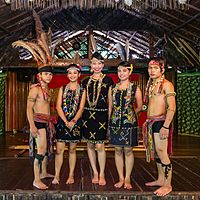Murut people
 Murut in traditional attire in Mari Mari Cultural Village, Sabah | |
| Total population | |
|---|---|
| 150,000 | |
| Regions with significant populations | |
Sabah including Labuan: 106,484 (2020)[1] Sarawak: 9,500 (1980)[2] Nunukan, North Kalimantan: 57 513 (2015), East Kalimantan Austronesian peoples |
The Murut are an indigenous
Etymology
The literal translation of murut is "
Demographics

A large percentage of the Murut communities are in the southwest interior of Sabah, East Malaysia, specifically the districts of Keningau, Tenom, Nabawan,Labuan and Beaufort along the Sapulut and Padas rivers. They can also be found inhabiting the border areas of Sarawak, (especially around the Lawas and Limbang areas, where they are also referred to as Tagal people), North Kalimantan (traditionally concentrated in Malinau Regency and Nunukan Regency), and Brunei.
The Murut population in
The Murut in Brunei and Sarawak (Southern Murut) is ethnically and linguistically different from Murut in Sabah (Northern Murut). In Sarawak, the confusing term "Murut" is hence replaced with the term "Lun Bawang", while this has not taken place in Brunei.[5] The Northern Murut is more commonly termed "Tagol" or "Tagal" in Brunei and Sarawak.
The Murut are divided between lowland (Timugon) and highland (Tagol) subgroups. They speak the
Customs and religion

The Murut were the last of Sabah's ethnic groups to renounce headhunting. As with the Iban of Sarawak, collecting heads of enemies traditionally served a very important role in Murut spiritual beliefs. For example, a man could only get married after he presented at least one head to the family of the desired girl.
The Murut were shifting cultivators of hill padi and tapioca, supplementing their diet with blowpipe hunting and with some fishing. They live in communal longhouses, usually near rivers, using the rivers as their highways. Most have now converted to Christianity, with about a fifth of the population being Muslims. However, they still maintain their culture.
Traditional dress for men was a jacket made of tree bark ( coins. Another belt made of reddish-brown glass beads plus yellow and blue beads was hung loosely around the waist.
Murut wedding or funeral feasts can last several days. Ancient Chinese jars hold a prominent status in Murut customs. Jars are also a place of spirits, and larger jars were formerly used as coffins.
Musical heritage
The Murut have a musical heritage consisting of various types of agung ensembles – ensembles composed of large hanging, suspended or held, bossed/knobbed gongs which act as a drone without any accompanying melodic instrument.[6][7]
Murut also used bamboo as a musical instrument, by using bamboo to compose songs. Some musical instrument like tangkung (similar to that of a guitar, except it has only two strings) is made from wood. Tangkung is usually played during their leisure time.
Ontoros Antanom/Antanum
Antanum was a famous and influential Murut warrior from Sabah who according to local oral history claimed to have supernatural powers. Because of this, he was able to receive support from the chiefs and villagers from around Keningau, Tenom, Pensiangan, and
Sub-ethnic groups


The Murut people are divided into three linguistic groups, namely:-
- Murutic languages cluster:
- Okolod (North Kalimantan, Indonesia)
- Keningau Murut (Keningau, Sabah, Malaysia)
- Tagal or Tahol Murut (Sabah, Malaysia and North Kalimantan, Indonesia)
- Paluan (Sabah, Malaysia)
- Selungai Murut (North Kalimantan, Indonesia)
- Timugon Murut (Sabah, Malaysia)
- Binta Murut (Sabah, Malaysia)
- Bulusu Murut (Kalimantan, Indonesia)
- Tingalan Murut (Kalimantan, Indonesia)
- Agabag Murut (Kalimantan, Indonesia)
- Northern languages cluster:
- Tidong languagescluster:
- Tarakan, North Kalimantan, Indonesia)
- Bulungan people (Bulungan Regency, North Kalimantan, Indonesia)
- Kalabakan (Sabah, Malaysia)
- Sembakung Murut (Sabah, Malaysia; North Kalimantan, Indonesia)
- Serudung Murut (Sabah, Malaysia)
Notable figures
- British North Borneo Companybut was killed while fighting with the company army in Sungai Selangit near Pensiangan
- Gaunon Lulus – Murut man who built a railroad from Melalap, Tenom, with Arthur Joseph West
- Andre Anura – Malaysian athlete from Tenom, Sabah
- Rubin Balang - former Sabah Minister.
- Riduan Rubin - MP Tenom and son of Rubin Balang.
- Noorita Sual – Malaysian Parliament member and Senator.
- Raime Unggi – former member of the Malaysian Parliament
- Tun Ahmad Koroh – fifth head of state of Sabah, also of partial Dusun ancestry
- Tun Mohamad Adnan Robert – sixth head of state of Sabah
- Tan Sri Suffian Koroh – former deputy chief minister of Sabah
- John Daukom – Olympic sprinter[9]
References
- ^ a b "2010 Population and Housing Census of Malaysia" (PDF) (in Malay and English). Department of Statistics, Malaysia. Archived from the original (PDF) on 11 October 2012. Retrieved 17 June 2012. p. 107
- ISBN 0-2959-7416-8.
- ^ "East-Kalimantan 48 Tribes". IndonesiaTraveling.com. Archived from the original on 4 August 2016. Retrieved 11 December 2011.
- ^ "Brunei: The Abode of Peace". Archived from the original on 9 November 2000. Retrieved 20 April 2007.
- ISBN 9781317659983. Retrieved 3 March 2017.
- ^ Mercurio, Philip Dominguez (2006). "Traditional Music of the Southern Philippines". PnoyAndTheCity: A center for Kulintang – A home for Pasikings. Retrieved 25 February 2006.
- ^ Matusky, Patricia. "An Introduction to the Major Instruments and Forms of Traditional Malay Music." Asian Music Vol 16. No. 2. (Spring-Summer 1985), pp. 121–182.
- ISBN 9789812308122.
- ^ Evans, Hilary; Gjerde, Arild; Heijmans, Jeroen; Mallon, Bill; et al. "John Daukom Olympic Results". Olympics at Sports-Reference.com. Sports Reference LLC. Archived from the original on 18 April 2020. Retrieved 15 August 2017.
